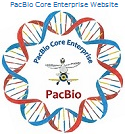Library Troubleshooting
Performance Issues -
Things which can cause libraries to perform badly (or not at all) on a Deep Sequencing Run

Nicked DNA:
When you submit a library, it is usually double stranded and built by PCR amplification. The strands are separated (denatured) to make the clusters/template, so the clusters sequenced from an Illumina library are built with single stranded DNA. If the DNA is nicked from the shearing, gel isolation and ETBR exposure, degradation, etc. then the required sequences at each end will not be present and a completed cluster will not be formed. To avoid nicking we recommend using SYBR to stain gels when doing gel purification and sizing. We also like the product from NEB called PreCR which repairs nicks very reliably.
Wide size range or several concentrated sizes in a mixture:
A wide smear will result in clusters of variable sizes and densities which are hard to image accurately. Since the most effective loading concentration can vary based on insert size, a wide range may also mean that loading is never optimized for all of your library. Smaller fragments will also amplify more efficiently during cluster formation and outcompete the larger ones. If you have a situation where you cannot size cut your library and request that we run at a lower density to compensate, we will be glad to, however note that your total sequence yield may be greatly reduced. If you have a multiphasic library, e.g. sizes centered around 2 or more different ranges, you will have cluster populations in 2 or more different sizes of consistent densities. The farther apart they are in size the more likely the detection software is to have problems. There are work arounds for this which generally involve making sub-libraries, please talk with us or with vendor-provided tech support.
Large (>800bp) insert sizes:
Very large libraries may have trouble sticking to the flowcell and just flow through. In some cases they might not stick but can get in the way and block smaller fragments from sticking as well. Some large libraries stick to the flowcell but form "blobby" spread-out clusters because the ends can spread further apart. They could then interfere with the imaging of "good" clusters because the signal from the big ones can overlap that of the small ones, preventing the instrument software from calling them correctly. For large libraries that do stick, cluster generation can also be incomplete because there aren't enough bridge amplification reagents to do the entire length of the template.
These potential issues are why the Core cannot guarantee the performance of libraries over 800bp.
Modified DNA:
Abasic sites created by some Taq Polymerases will prevent amplification. Modifications which interfere with annealing/amplification or change the Tm can also prevent good cluster formation. The LACK of the modifications on the Illumina primers (which have proprietary LNA modifications) will result in fewer clusters, so if you are making your own, please note this and pay careful attention to the Tm.
Primer Dimer or Primer excess:
These will stick to the available positions on the flow cell and give you lots of sequences you really don't want. Gel purification or an extra bead/column cleanup of the final product is highly recommended, as is the Topo Cloning to ensure that what goes on the flow cell is indeed what you want.
Inhibitor(s) in the sample:
This is most often leftover DNA purification beads or resin transferred into the sample tube and sent along with the finished product. PEG from unwashed Ampure beads can also inhibit cluster formation. Library products that have not been cleaned up will also be inhibited, and QC may be inaccurate. TE buffer and other buffers with high levels of EDTA can also interfere, so we recommend submitting in water or EB as requested.
Modified Adapters / Custom Sequencing Primers:
The various Illumina instruments have slight differences in the temperatures at which cluster generation is carried out. Any adapters requiring a custom sequencing primer must be carefully planned so the Tm is acceptable for the instrument you want to run on (to avoid a failure to anneal), and so the primer does not interfere with the standard Illumina primers (on multi-lane flowcells, primers for certain reads are drawn from a single pool). We strongly recommend that you have your custom primer pre-approved by the Core. If your primer cannot be safely mixed with the standard Illumina primers, we may be unable to run your library.
Tips for Improving Libraries

Extra washes:
An extra bead cleanup after the library is complete can help rid the library of any leftover primer-dimer, help get rid of any inhibitors, and improve cluster seeding in terms of yield and unique reads.
Base Balance:
If you have homogenous sequences in your library insert, you may need phiX control added by the Core during sequencing to balance the bases. Ideally there should be roughly equal amounts of all 4 bases. At a minimum there must be signal for each laser/light source - A and C are read with one laser, G and T with the other. On instruments like the MiSeq where there is no control lane, lack of base balance can cause the run to terminate prematurely. The same consideration applies when choosing indexes. Picking indexes that are base-balanced will improve the run and help avoid "index-switching" (mis-assignments that occur when indices aren't different enough).
Longer index length:
If you have a large number of indices, the chance of overlap becomes higher. Choosing 8-base or 10-base indices will allow for more than one base mismatch in the index read, creating a cushion for errors during sequencing or base-calling.


